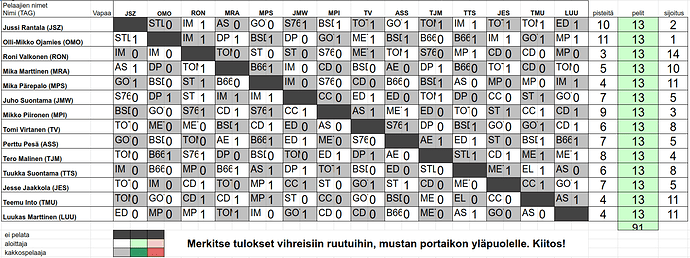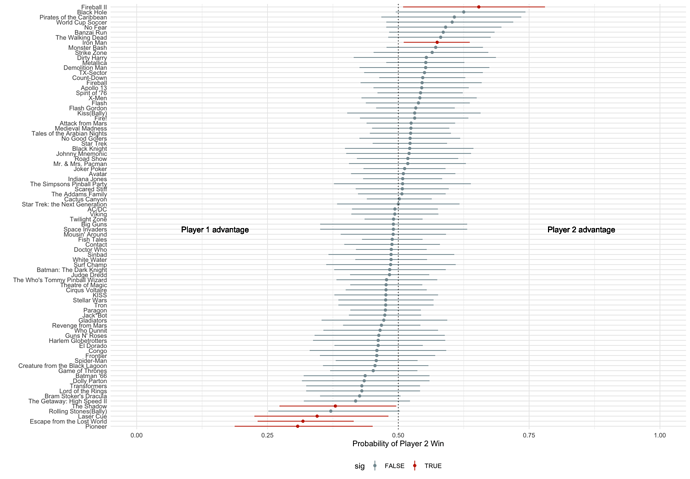We’re you just looking at the raw data? Depending on the format, player position is often correlated with player skill/qualifying position. For example, higher seed often plays in position 1. So even if there is an advantage for playing second, that may be washed out in the raw data. The analysis would need to account for confounding variables if you want to get an uncontaminated look at the influence of player order.
Our qualifying format was such that everyone played both positions as equally as possible, with no significant relation to seeding. It was like this all 10 seasons. Player order was predetermined for each game, the color of the cell on your spreadsheet row signalled if you were 1 or 2. Machine choice was random pick from all machines that were available upon start of match.
I can pull data but I am not sure it’ll provide answers. It’s not unusual for the player order in Match Play to not match the actual order the games were played.
I know my events are a mixed bag. It’s either we play in the order on the screen, or we use the order on the screen to determine game choice/player order and don’t always go back to re-arrange player order.
Ah, yeah if order and games were randomly assigned then no worry about self selection issues. It would be interesting to follow up and see if player order differences varied across machines.
I guess I’m not too surprised there wouldn’t be a noticeable difference between first and last position. The benefits of going last are mostly situational. For example, on ball 3 after player 1 has completed their ball, player 2 now knows exactly how many points are needed to win, and they can adjust their strategy if it makes sense. Otherwise, they are still just playing the same strategy and there really isn’t an advantage. Playing last also helps if you aren’t familiar with a particular game-- you can watch opponents to learn strategy or feeds. However, if everyone is already familiar with the rules or how particular games play (like in league play), it probably doesn’t matter.
@JSZ Shared their head to head data with me and I put together this analysis on player order effects by game. The TLDR is that some games skew towards maybe having a order advantage, but only a handful of them are statistically significant.
P2 advantage: Fireball 2 & Iron Man.
P1 Advantage: The Shadow, Laser Cue, Escape from the Lost World, & Pioneer.
The P2 advantages make sense. Not sure on the games with a P1 advantage. Could just be random nonsense. Anyone have a theory?
Are these all on a single copy of the given game?
The database has 13’113 two player games played over a 10 year period at a few different collections; in general there is a good chance that more than one copy of a game is involved. Fireball II was ever played at one location (between 2016 - 2019) so I assume that was always the same machine.
What confidence measure are you ploting? 95% confidence interval?
Considering that Pioneer is a completely symmetric game with no carryover, I wonder if maybe the player 2 reels are just glitching or something? Unlike most of the other games I can’t think of any reason why player 1 would have such a large advantage on it
yes, 95% CI
Thanks for pointing this out. This also means that we have a 5% error rate, so we’d expect at least 4 false results.
I would guess random nonsense. It would be surprising if there weren’t a couple of outliers. Maybe the Shadow you could come up with some advantage for player 1 with physical locks and skill shots, but it seems unlikely.
OMG the thought of possibly discovering a score reel malfunction on a machine 5000 miles away by only looking at match data fills me with so much joy.
I would say certain games are just more generally popular than others, like for instance I bet you’d see player 1 win on black rose more than player 2 because only someone who likes black rose is gonna pick it and therefore be player 1, and since it’s not an evergreen game like AFM, the person who picked it will usually have a huge rules advantage
I agree, but in the case of this dataset player order and machine selection is random so that is not a factor here.
I like to go 1st on EMs for exactly this reason. I find more issues occur on later score reels because they are less used.
This is exactly the reason we do single player only for the tournaments we run.
This is also why for Indisc I test all players’ scoring reels for the EMs we use, and advise other TDs to do the same for their events. It’s better to play with all 4 players when possible, but a good TD will make sure that’s viable first and adjust accordingly if not. It does take extra time, which isn’t always available depending on how far in advance of the start of competition the TD has access to the games. At shows where the TDs are relying mostly on donated games, they often don’t get to test and adjust the settings on games until just a few hours before play begins. Those are the situations when it’s most important to do the multi-player testing and if you can’t, make the call for single or two-player games only (if you can’t test all 4 on every game, do you have time to test 1 and 2 or 1 and 3?).
At INDISC all the machines are running as 1P for at least 8 hours, happily stepping away, and wiping all the contacts in those score reels. And the other 3 sets of reels have sat on zero that whole time. I don’t recall anyone running them through scoring before finals start.
It is good they where tested during setup, but it doesn’t mean they still work as well come finals.

